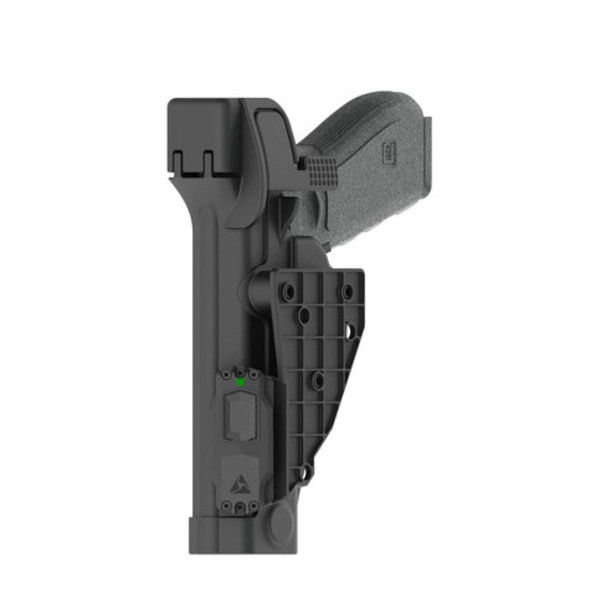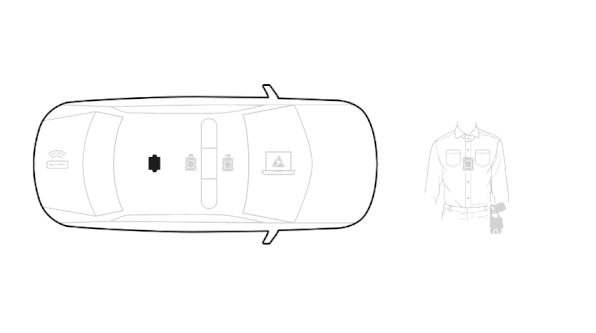Technology, no matter how smart, only works if you use it, or simply remember to turn it on.
To ensure accountability during police encounters, Axon, Taser’s police body camera division, has announced a small sensor for gun holsters that can detect when a gun is drawn and automatically activate all nearby cameras. The sensor, Signal Sidearm, is part of a suite of products aimed at reducing the possibility that officers will fail to or forget to switch on their cameras during encounters with the public. Last year in Chicago for instance, an officer, when giving chase, said he forgot to turn on his camera before fatally shooting an unarmed 18-year-old named Paul O’Neal.
Taser also sells sensors that activate the company’s body cameras and dashboard cameras when a police cruiser’s door has opened or its lights have been switched on, as well as a battery pack for the Taser electroshock weapon that prompts cameras to record when the weapon is armed. By activating all cameras within a 30-foot radius, the suite of products can help police create a multi-angle video of a police encounter. (Taser’s cameras are also equipped with a historical buffer that captures footage up to two minutes prior to a camera’s activation.) Many police dashboard cameras are already designed to activate when the engine is started or a siren is turned on, and another camera maker, Vievu, also sells a holster that automatically triggers its cameras. In the future, body cameras could be activated when an officer enters a hot spot or makes a call on the radio.
“When law enforcement officers must draw a weapon, the last thing they should worry about is their technology,” Rick Smith, Taser’s CEO and cofounder, said in a statement. “The Signal Sidearm will give officers the same confidence in their technology that already exists in encounters involving Smart Weapons that use our Signal technology. It’s an important step in extending the reach of the Axon network to connect other devices.”

A number of police departments have already begun to deploy the suite of sensors, called Axon Signal, which Taser markets as part of a brisk business selling services as well as products to police departments. In an earnings report released today, Taser said its revenues from body cameras increased 154% to $23.7 million in the fourth quarter of 2016, compared to $9.4 million in the fourth quarter of 2015, far outpacing the growth of its weapons sales. Roughly 6,000 of the 18,000 law-enforcement agencies in the U.S. are thought to be using body cameras in some form, and some estimates put the the market for body cameras and services at $1 billion a year.
It’s a fierce business, too. The Signal ecosystem is currently the subject of a lawsuit by police camera company Digital Ally, which claims that Taser is infringing Digital’s patents on a similar technology. Taser has called the suit frivolous.
Taser’s holster sensor is scheduled for release later this year, but the company has not said how much it would cost. Last year, according to a Taser price list, a standard Axon Flex camera equipped with Signal cost $688, and a basic 1-year subscription to Evidence.com with 100 GB of cloud storage cost about $150 per officer.
Automatically activated cameras won’t be completely effective at providing oversight of police encounters: As happened when Baton Rouge police shot Alton Sterling last year, cameras can fall off during physical encounters, a problem that Taser has worked to address. They can also malfunction, or videos can be deleted. And civil liberties advocates complain that cameras are only as effective as the rules that guide their use: In Seattle, where the city council voted (March 17, 2017) to approve $2 million for body cameras, the ACLU has complained that current city policy allowing officers to switch cameras off for privacy reasons gives police too much discretion over when to record.

Other issues with cameras being resolved at the local level include the heavy costs of cloud video storage, and the question of whether officers are allowed to view their footage immediately after violent encounters—a privilege not extended to the public. As Seattle’s police chief, Kathleen O’Toole, said in 2015, cameras will be a “valuable tool” for police and public accountability. “But I think we have to be realistic: Body cameras are not going to be a panacea.”
A large majority of Seattle’s citizens support body cameras for cops, echoing surveys across the country, and police reform advocates insist that cameras can help reduce use-of-force encounters. In a study of police departments in the United States and the U.K. conducted by researchers at Cambridge University, the technology was found to result in lower rates of complaints against officers, and to reduce some use-of-force encounters. But when policies did not require officers to be recording all interactions with the public, use of force rose.
In a story last year, I explored some of the ways body cameras are not working as intended or hoped.
Fast Company , Read Full Story
(65)
